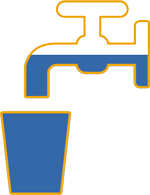Asset: Advancing Equitable and Circular Water Solutions Through Source Separation
Funder: National Science Foundation Convergence Accelerator (Phase 1)
Collaborators: Water Research Foundation, PHLUSH, Brightwater Tools, University at Buffalo, University of Michigan, Northwestern University and Columbia University, and regulatory consultant Mathew Lippincott
Project Goals
After decades of effort, existing treatment systems only recover 11% of nitrogen and 21% of phosphorus, and they are approaching their limits. Research has shown that urine recycling reduces energy consumption up to 40% and cuts greenhouse gas emissions nearly in half compared to conventional treatment.
For over a decade, Rich Earth Institute and Nancy Love’s Nutrient-Energy-Water Cycles Group at the University of Michigan have been collaborating on advancing urine recycling solutions. University of Michigan supported the development of treatment technologies now being advanced through our spin-off company Brightwater Tools. Now, with support of the University administration, the UM team is scaling up to meet the University’s sustainability goals for fertilizers, initiated through their ‘Pee for the Peonies’ project.
This project aims to synchronize the work of communities, researchers, manufacturers, plumbers, landscapers, and farmers to grow and sustain a urine recycling industry. Our team is (1) defining all components of the urine separation ecosystem and (2) identifying needs, key partners, and a timeline for advancing these components. Examples of key components of the urine separation ecosystem include: collection and processing technologies; plumbing and fixture standards and codes; policy and regulations; the economics and business model; life cycle impacts and sustainability contributions; workforce development; and user perceptions.
Methods
The project includes four core action areas:
1) User-centered design
We conducted interviews with key stakeholders, including wastewater utility managers, regulators, planners, builders, plumbers, and horticulturalists. We also held a series of co-design workshops which enabled us to develop a set of urine diversion design principles.
2) Regulation
In collaboration with Mathew Lippincott, Rich Earth hosts an ongoing EcoSan Permitting Group, which fosters state-state knowledge sharing about regulatory strategies.
3) Preliminary design of prototype mobile unit
We hosted several workshops to inform the development of a mobile urine recycling unit, including at the 2024 Rich Earth Summit. Feedback included system design, communication goals, and priorities for accompanying education modules.
4) Commercialization & workforce planning
We clarified key economic drivers for urine recycling in regions with key drivers such as nutrient pollution issues or demand for sustainable fertilizers.
Results
Watch Our Overview Video
Design Principles
We created a set of Urine Recycling Design Principles with the goal of guiding the design of pilot urine recycling systems by our research team. We are also sharing them with the urine recycling community so they may be adapted/translated to other contexts and further refined as they are used. The principles were developed through an iterative process with several different groups of people. Initially, a virtual co-design workshop was held in May 2024 where participants with backgrounds in environmental justice, ecological sanitation, and rural sanitation worked through exercises that led to the suggestion of ideal design principles. These suggestions were then presented for feedback at the Asset All-team Meeting in Ann Arbor later that May. Asset team members provided additional comments in a follow-up All-team meeting, and Rich Earth Institute staff also provided feedback.
Watch a presentation about these principles via the 2024 Rich Earth Summit recordings, under the heading ‘design.’


